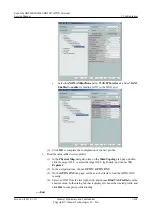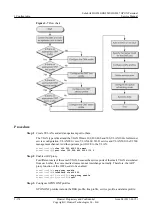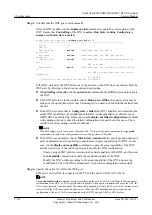
huawei(config-if-gpon-0/1)#
ont port native-vlan 1 1 eth 1 vlan 10
huawei(config-if-gpon-0/1)#
ont port native-vlan 1 2 eth 1 vlan 10
Step 7
Configure traffic profiles.
You can run the
display traffic table ip
command to query the traffic profiles existing in the
system. If the traffic profiles existing in the system do not meet the requirements, you need to
run the
traffic table ip
command to add a traffic profile.
l
HSI service: The profile ID is 8, the CIR is 4 Mbit/s, the priority is 1, and packets are
scheduled according to the priority carried.
l
VoIP service: The profile ID is 9, no rate limitation in the upstream and downstream
directions, the priority is 6, and packets are scheduled according to the priority carried.
l
Wi-Fi service: The profile ID is 10, the CIR is 6 Mbit/s, the priority is 1, and packets are
scheduled according to the priority carried.
l
U2560 management channel: The profile ID is 11, no rate limitation in the upstream and
downstream directions, the priority is 7, and packets are scheduled according to the priority
carried.
huawei(config-if-gpon-0/1)#
quit
huawei(config)#
traffic table ip index 8 cir 4096 priority 1 priority-policy tag-In-
Package
huawei(config)#
traffic table ip index 9 cir off priority 6 priority-policy tag-In-
Package
huawei(config)#
traffic table ip index 10 cir 6144 priority 1 priority-policy tag-In-
Package
huawei(config)#
traffic table ip index 11 cir off priority 7 priority-policy tag-In-
Package
Step 8
Create service ports.
l
HSI service: Set the service port indexes to 1 and 2, SVLAN ID to 100, GEM port ID to 1,
and CVLAN ID to 10. Use traffic profile 8.
l
VoIP service: Set the service port indexes to 3 and 4, SVLAN ID to 200, GEM port ID to 2,
and CVLAN ID to 20. Use traffic profile 9.
l
Wi-Fi service: Set the service port indexes to 5 and 6, SVLAN ID to 400, GEM port ID to
3, and CVLAN ID to 40. Use traffic profile 10.
l
U2560 management channel: Set the service port indexes to 7 and 8, SVLAN ID to 500,
GEM port ID to 4, and CVLAN ID to 50. Use traffic profile 11.
huawei(config)#
service-port 1 vlan 100 gpon 0/1/1 ont 1 gemport 1 multi-service
user-vlan 10 rx-cttr 8 tx-cttr 8
huawei(config)#
service-port 2 vlan 100 gpon 0/1/1 ont 2 gemport 1 multi-service
user-vlan 10 rx-cttr 8 tx-cttr 8
huawei(config)#
service-port 3 vlan 200 gpon 0/1/1 ont 1 gemport 2 multi-service
user-vlan 20 rx-cttr 9 tx-cttr 9
huawei(config)#
service-port 4 vlan 200 gpon 0/1/1 ont 2 gemport 2 multi-service
user-vlan 20 rx-cttr 9 tx-cttr 9
huawei(config)#
service-port 5 vlan 400 gpon 0/1/1 ont 1 gemport 3 multi-service
user-vlan 40 rx-cttr 10 tx-cttr 10
huawei(config)#
service-port 6 vlan 400 gpon 0/1/1 ont 2 gemport 3 multi-service
user-vlan 40 rx-cttr 10 tx-cttr 10
huawei(config)#
service-port 7 vlan 500 gpon 0/1/1 ont 1 gemport 4 multi-service
user-vlan 50 rx-cttr 11 tx-cttr 11
huawei(config)#
service-port 8 vlan 500 gpon 0/1/1 ont 2 gemport 4 multi-service
user-vlan 50 rx-cttr 11 tx-cttr 11
Step 9
Configure the queue scheduling mode.
Use the 3PQ+5WRR queue scheduling. Queues 0-4 adopt the WRR mode, with the weights of
10, 10, 20, 20, and 40 respectively; queues 5-7 adopt the PQ mode.
EchoLife HG8240/HG8245/HG8247 GPON Terminal
Service Manual
3 Configuration
Issue 04 (2011-01-12)
Huawei Proprietary and Confidential
Copyright © Huawei Technologies Co., Ltd.
3-179






























